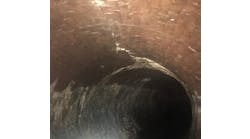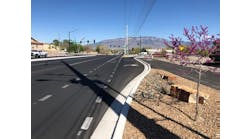In 1996 a group of scientists from the National Oceanic and Atmospheric Association (NOAA) conducted a sediment toxicity survey of 22 estuaries in the United States. Newark Bay in New Jersey topped that list for concentrations of toxicity. The bay's proximity to high hubs of industry and transportation (including Newark Liberty International Airport) has meant that is has long been the receptacle of industrial waste as well as high doses of non-point source pollution.
When Continental Airlines opened its much awaited Global Gateway at Newark Liberty International Airport in late 2001, airline passengers reveled in the improved traffic flow, easier check-in and arrival procedures, increased gate capacity (by nearly 50 percent) and award-winning concessions featuring mall-style retailers and an international food court. Terminal C, the centerpiece of the $1.4 billion expansion of Newark Liberty also included some cutting edge stormwater treatment technologies to help remove pollutants from the runoff of the airport's roadways, runways and airplane taxiways prior to discharge into Newark Bay. While few will ever see the technology, now buried beneath the tarmac of the airport's taxiways, the system demonstrates the effectiveness of applying stormwater treatment technology to an already congested area where competition for space is fierce.
Airports potentially can generate enormous amounts of polluted stormwater runoff. In addition to hydrocarbons such as oil and fuel from cars, trucks and planes, winter weather brings added sand and salt to the roadways. Expanding the terminal area for Continental's new Global Gateway included increasing the paved areas around the terminal to accommodate the new taxiways and roadways. Stormwater runoff volumes increase as a result of the additional impervious surfaces, and so does the resultant non-point source pollution.
Expansion
The expansion of the terminal triggered the need for stormwater permits. The Phase I rules of NPDES required that runoff be treated to ensure that oil/hydrocarbon concentrations did not exceed 15 parts per million (ppm), and that solids be reduced through treatment down to the 50 micron particle level. Prior to the expansion, stormwater from the paved terminal and parking areas was directed to a nearly 60' wide peripheral ditch that led to a pump station that discharged the water directly into Newark Bay. Now, stormwater from the site is directed first to a stormwater treatment train that will remove solids such as sediment, debris and hydrocarbons such as oil and fuel, before being released into the ditch.
Due to the size of the treatment area, the storm flows from the paved areas around the terminal will be quite large. Therefore, runoff is conveyed via a 66" pipe that can handle flows of up to 80 cubic feet per second (cfs). The water hits a flow-splitting device that routes the runoff to two separate treatment systems. Project engineers designed the treatment train to incorporate two cast-in-place hydrodynamic separators from Vortechnics, Inc., Scarborough, Maine, combined with four oil and water separators from Highland Tank, Stoystown, Pa.
Stormwater runoff from the paved areas of Terminal C is directed first to the pair of hydrodynamic separators that have been shown in field tests to remove 80 percent of total suspended solids (TSS) on a net annual basis. These systems use a combination of vortex motion, flow controls and a series of baffle walls to help trap floatable oil and gas while also capturing sediment that has been shown to carry other pollutants such as lead, zinc, cadmium and copper. Full-scale laboratory tests of the system have consistently demonstrated that the unit is capable of removing particles down to 50 microns. Because the system can be cast in place, it was the most practical system to install to handle the large flows from the site. Each of the Vortechs systems is 18' wide by 30' long, and 9'3" deep. Because the units are buried under taxiways for the terminal, they had to be constructed to meet B-747-400 Aircraft loading requirements.
"It is somewhat uncommon for treatment equipment like this to be buried under pavement requiring the kind of load bearings necessary for a 747," said Francis Tighe, vice president of Vortechnics. "We designed each of the roof slabs for the cast-in-place units with a steel cross beam to help meet the loading specifications, and there are steel reinforced concrete columns in the baffle walls of the units for additional structural strength."
After treatment in these systems, the stormwater enters one of four oil and water separators to further remove oily contaminants from the stormwater. The tanks for the oil and water separators were specially constructed of 3/8" steel with 1/2" by 6" reinforcement rings to ensure the tanks could withstand pressure from the burial depth and surface loading. This combination of systems is designed to reduce oil concentrations to 10 ppm.
The two systems complement each other, with the hydrodynamic separators helping to optimize the coalescing capacity of the oil and water separators. The result is that water discharged from the units into the perimeter ditch is now free of most of the solids and debris carried from the roadway in stormwater and the oil is reduced to 10 parts per million. From the ditch, the cleaner treated water is pumped into Newark Bay.
Installation
Installation of the huge stormwater treatment systems at Terminal C was complicated by heightened airport security. The large Vortechs Systems, made of concrete that had to be cast in place at the job site, were installed in the fall of 2001.
"Getting the trucks and workers onto the job site became much more difficult because security was so tight," said Henry Meyers, president of Anselmi and DeCicco, Inc., the general contractor for the job. "Every truck had to be escorted to the site by security personnel."
In addition, Meyers said that the underground installation of the units happened while the airport was operational. This meant work had to stop any time a plane traveled near the excavation.
"We had to install these huge units into a hole that was 22' deep. The aircraft's wing came within 20' of the excavation site, and it wasn't feasible to just dig a big hole in the ground," he said.
The wheel loading for a Boeing 747 is quite large, so care was taken to keep the taxiway far away from any soil that could give way. In addition, a big exposed hole in the ground could result in the jet engines sucking debris from the hole.
"So we ended up using sheeted excavation to help maintain the integrity of the taxiways and keep the construction zone compact. By driving steel sheeting for excavation with internal bracing, we could keep the hole as small as possible," Meyers said.
Once installed, the stormwater treatment systems were covered by tarmac and are accessible for inspection and maintenance from grade. Quarterly inspections are recommended during the first year, followed by annual inspections and cleanout with a vacuum truck to remove accumulated sediment and debris as needed. The oil and water separators include a corrugated plate to trap solids and oil coalescing material to trap oil, both of which should be inspected every six months and power washed as needed.
Airport sites in general pose a variety of environmental challenges in terms of air and water pollution. The stormwater treatment systems in place at Continental's Global Gateway at Newark Liberty Airport demonstrate how new stormwater treatment technologies can help control non-point source pollution and ensure cleaner water, even in highly industrialized areas.


